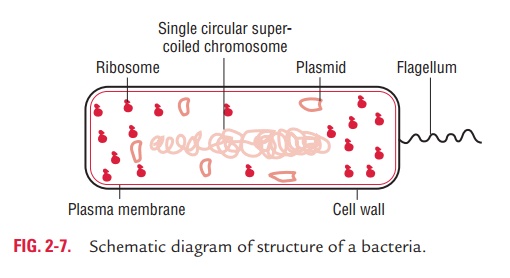Chapter: Microbiology and Immunology: Morphology and Physiology of Bacteria
Nucleus - Structure and Functions of Bacterial Cell Envelope
Structure and Functions of Bacterial Cell Envelope
The outer layer or cell envelope provides a structural and physiological barrier between the protoplasm (inside) of the cell and the external environment. The cell envelope protects bacteria against osmotic lysis and gives bacteria rigidity and shape. The cell envelope primarily consists of two components: a cell wall and cytoplasmic or plasma membrane. It encloses the proto-plasm, which consists of (i) cytoplasm, (ii) cytoplasmic inclu-sions (mesosomes, ribosomes, inclusion granules, vacuoles), and (iii) a single circular DNA (Fig. 2-7).

Nucleus
The bacterial nucleus is neither enclosed in a nuclear membrane nor
associated with any nucleolus. It is
haploid and replicates by simple fission. The nucleus of the bacteria consists
of a single circle of double-stranded deoxyribonucleic acid (DNA), arranged in
a supercoiled circular structure. It measures about 1000 mm when straightened.
The chromosome is located
in an irregularly shaped region called nucleoid, but often referred to as
bacterial chromosome because of the analogy with the eukaryotic structure. The
nucleoid is visible through the light microscope after staining with the
Feulgen stain, which specifically reacts with DNA.
In actively growing
bacteria, the bacterial DNA can account for up to 20% of the volume of the
bacterium and has projec-tions that extend into the cytoplasmic matrix. Careful
electron microscopic studies often have shown the nucleoid to be in contact
with either the mesosome or the plasma membrane.
Many bacteria also
possess smaller circles of extrachromo-somal DNA called plasmids. The plasmids
are double-stranded DNA molecules, usually circular, that can exist and
replicate independently. Plasmids are not required for host growth and
reproduction, although they may carry genes that confer the bacterium with
properties such as antibiotics resistance or the capacity to produce toxins or
enzymes.
Related Topics